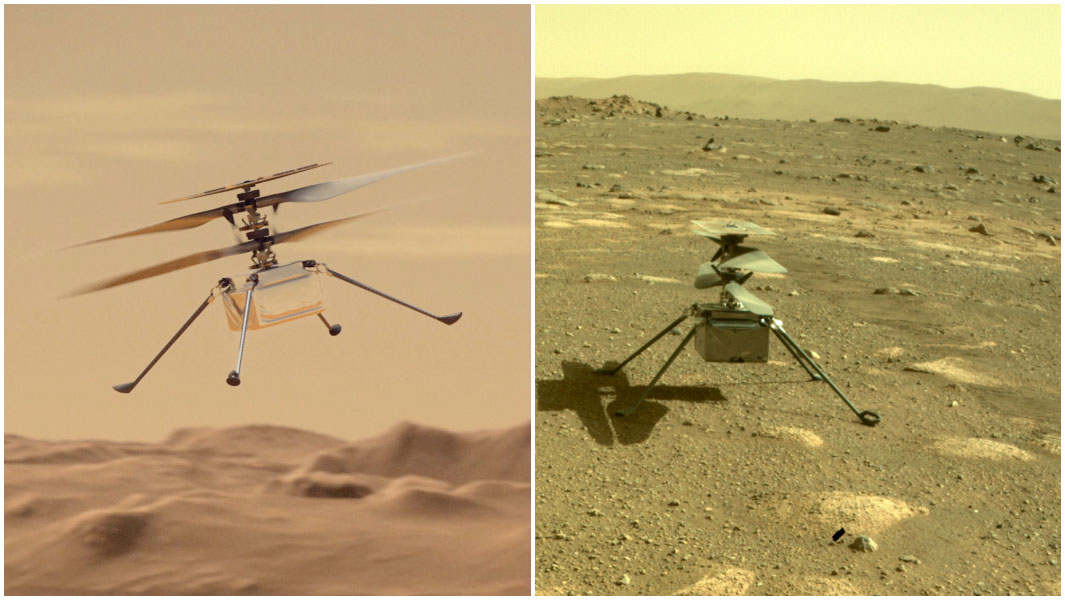The self-flying helicopter setting world records on Mars

Martian ‘air’ is extremely difficult to fly in due to the planet’s thin atmosphere.
Being 95% carbon dioxide with little oxygen, it has a pressure of just 610 pascals (0.006% of Earth's typical atmospheric pressure), rendering aircraft rotors and lifting wings much less effective.
However, one tiny helicopter has been able to withstand the adverse conditions to set multiple world records.
NASA's Mars helicopter Ingenuity achieved the first controlled flight on Mars on 19 April 2021, when it flew for a total of 39.1 seconds by ascending to an altitude of 3 m (9.8 ft), hovering for 30 seconds, then landing.
A year later, on 8 April 2022, Ingenuity set several records with its 25th flight, when it travelled 704 metres (2,309 ft) across Jezero crater. Officially the farthest flight on Mars to date, it also set a new groundspeed record (5.5 metres per second) and a new record for flight duration (161.3 seconds).
Its highest altitude gained within one flight was on 3 December 2022, when it soared 14 metres (46 ft) above Mars' surface.

Ingenuity is engineered differently to Earth-based helicopters.
It gets its lift from a pair of contra-rotating carbon-fibre rotors, each of which has a diameter of 1.2 m (4 ft) and spins at around 2,400 rpm, which is about five times the speed of an ordinary helicopter.
On Mars this provides only enough thrust to lift an aircraft the size of a bag of flour. Ingenuity has a mass of 1.8 kg (4 lb), resulting in a weight of 680 g (1.5 lb) in Martian gravity.
It takes 5-20 minutes for a radio signal to reach Mars from Earth, meaning Ingenuity’s flights can’t be controlled in real time.
Instead, Ingenuity flies itself.
It is controlled by an onboard computer, which executes each flight plan autonomously.
In the weeks before each of Ingenuity’s flights, mission planners at NASA’s Jet Propulsion Laboratory send a series of waypoints and landmarks that define the route it must follow.

It is also equipped with a suite of instruments - including a navigation camera, an inertial measurement unit, and a laser range finder - which feed into the onboard computer, allowing it to instantaneously react to flight conditions without pre-programmed human input.
This is necessary because Mars’ thin air makes Ingenuity's rotors prone to stalling or loss of control, so the computer needs to make constant small control inputs to keep the helicopter stable.
When Ingenuity landed on Mars with NASA’s Perseverance rover in February 2021, its navigation system was designed with the assumption that it would only be making a few short, simple flights over relatively flat terrain near Perseverance’s landing site.
As it has encountered more complex terrain on its travels, software updates and creative workarounds have been required to keep Ingenuity fit for purpose and out of danger.
For example, in areas where it’s expected to struggle with landmark acquisition, its forward motion slows down.

When NASA’s Jet Propulsion Laboratory began the Mars Helicopter project, they weren’t even sure that powered flight on Mars was possible.
However, Ingenuity has passed every test with flying colours, proving that Mars’ thin atmosphere is indeed navigable by aircraft.
Although it does not carry any scientific instruments thus cannot tell us much about Mars itself, Ingenuity has taught us many valuable lessons for the development of future Mars-bound aircraft.
In time, Ingenuity’s successors will be capable of scouting currently-inaccessible sites and setting more out-of-this-world records.
Want more? Follow us across our social media channels to stay up-to-date with all things Guinness World Records! You can find us on Facebook, Twitter, Instagram, TikTok, LinkedIn, and Snapchat Discover– including our in-depth Curious Casebook series.
Don’t forget, we’re also on YouTube!
Still not had enough? Follow the link here to buy our latest book, filled to the brim with stories about our amazing record breakers.


